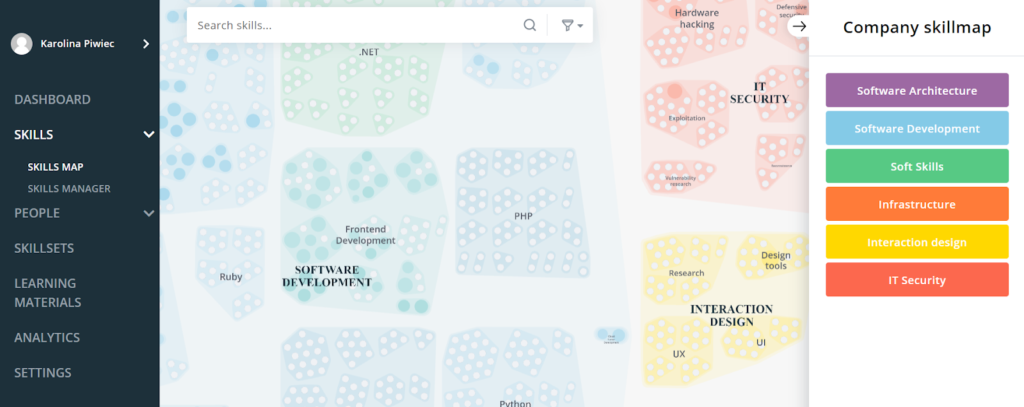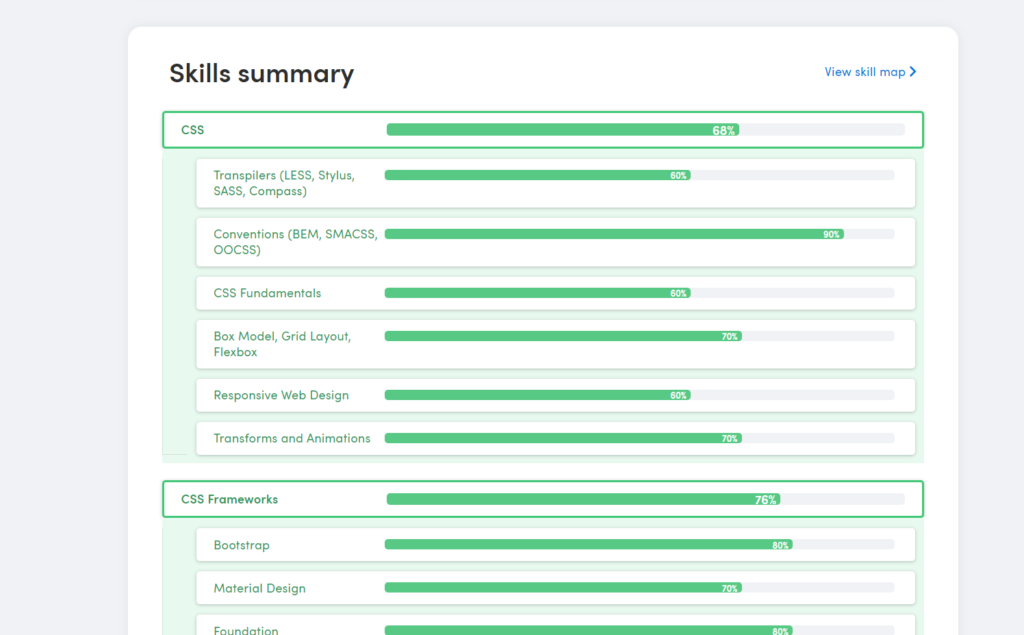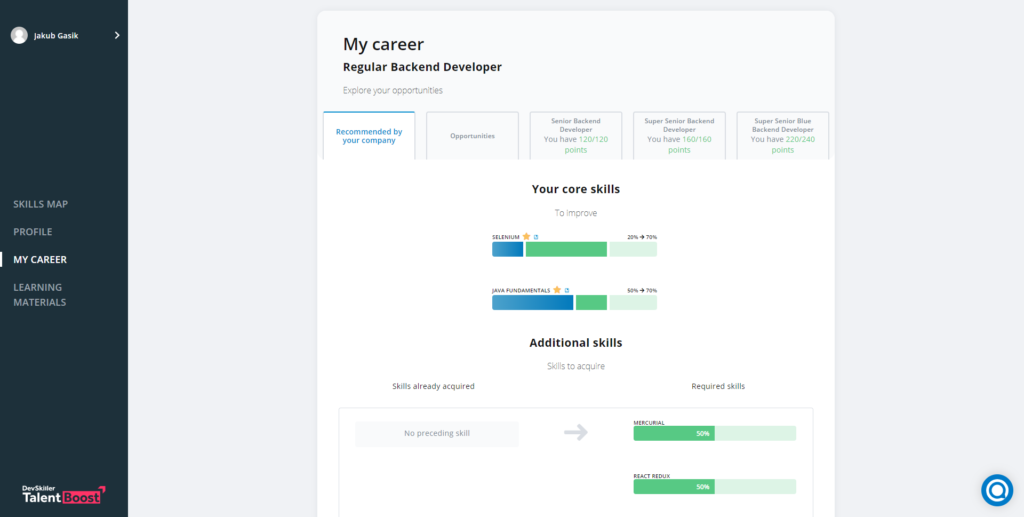What is talent management? An all-in-one guide

Introduction
The relationship between talent management and organizational success is evident. Finding a balance between managing existing employees and attracting the right new ones, is the key to success. In fact, as a McKinsey article put it, “organizations must consider investing in their existing workforce’s skills as well as attracting and retaining the right new talent.”
In the following article, we’re going to look at what talent management is, and how you can strategize to create an effective talent management process.
What is talent management and why is it important?
Talent management is an ongoing process that involves attracting and recruiting new employees and retaining and nurturing existing talent. The role of a talent management strategy is to create a workforce of individuals who help your company achieve its organizational goals. It’s also a critical element of any HR strategy.
As explained by Capterra, effective talent management pertains to such critical HR facts like:
- Recruiting
- Onboarding
- Performance management
- Compensation planning
- Succession planning
- Learning and development (L&D)
- Workforce planning
The benefits of a talent management strategy
Effective talent management in companies can bring significant benefits.
1. More efficient recruitment
Talent management gives you insights into what skills are available within the company and what skills are missing so that you can create recruitment initiatives around this. Is bringing a new employee on board really necessary? Or will further training a current employee suffice to cover for the missing skill?
A bird’s eye view of the existing skills and skill gaps across the whole organization helps you determine the right course of action on a case-by-case basis.

Source: TalentBoost
Recruiting for a few positions concurrently is not only costly but also time-consuming. Having a talent management solution in place will help you with skills prioritization.
Some positions can be filled later, without hurting the company’s performance. When the skills of your employees are mapped in the form of a skills matrix, it’s much easier to see the skills gaps and prioritize talent management initiatives accordingly.
2. Good employer branding
One of the key criteria companies use while deciding whom to work for, is good career growth opportunities. In fact, according to Stack Overflow, of developers looking for work, 35% are, “seeking growth or leadership opportunities.”
Source: Stack Overflow
Having a talent management plan in place will boost your employer branding which will translate into more valuable job applicants. You can talk about your approach to managing talent in your job description – let potential candidates know you take their development seriously. You can make use of your career paths early on in the recruitment process and feature them in the respective job ads, as well as present them in the interview.
Read: 5 simple techniques to improve Time to Hire in tech
3. Performance Management

There are hidden gems in every organization – part of managing people effectively is monitoring employee performance and identifying those due for promotion. Not only will you improve employee morale, but you’ll also help to retain employees and save yourself from unnecessary recruitment.
Searching for talented people within your company is an effective talent acquisition tactic. Many talented employees already operate within your company infrastructure. There is potentially untapped, diverse talent that is not being utilized. In tech, an internal talent strategy is especially important because, for digital skills, progress isn’t linear. This means some new IT skills are easier to acquire if you already have certain other skills.
4. Reduced turnover
In a piece on employee motivation, Inc.com aptly notes that:
“If employees are given the tools and the opportunities to accomplish more, most will take on the challenge”.
Recognizing your employees’ potential and supporting top talent in their career path will go a long way to reducing employee turnover. It is very effective for employee retention and for developing employees to reach their potential.
When you include career opportunities and training as part of your talent management approach, you minimize the chances of employees leaving due to a lack of skills development. This leads us to the next benefit…
5. Talent management as a business strategy – reduced skill gaps
Skill gaps can be observed across all industries and at companies of all shapes and sizes. If left unaddressed, they can harm your business and employee satisfaction levels tremendously! One of the ways of addressing this issue is by helping your programmers acquire new competencies. By doing so, you’ll be killing two birds with one stone – your employees will feel their careers are being invested in which will boost their overall performance, while your company will make sure no skills gaps are standing in the way of business development. Realigning an employee’s career goals and being sure to track progress as it is made, is one of the key components of creating a healthy company culture
6. Assigning people to projects more efficiently
Last, but not least, instating a talent management strategy will help you better assign developers to projects. By understanding the skills each employee has – or wishes to acquire – you’ll know who to suggest for any upcoming work.
This is an especially important benefit for service, project-based companies like software development agencies.
Check out:The 15 best recruitment methods for effective IT hiring
Talent management process
There are four key elements of an effective talent management process – it should be ongoing and cyclical.
Source: Hudson and Research Consulting
Acquisition
The starting point of the talent management model is acquisition. It includes activities such as sourcing and recruiting talent, employer branding, and onboarding of new hires.
It’s worth mentioning that according to AWS data, “87% of organizations accelerated their pace of digital adoption during the pandemic”. At the same time, reports that only 1 in 4 professionals feels ready to work in a digital-first world.
Given the size of the global digital skills gap, it’s impossible for companies to rely on recruitment alone.
Assessment
Assessment involves evaluating your employees’ skills, identifying the skills which are at your disposal, and spotting skills that are missing. This should be a continuous process to monitor your acquisition needs and succession planning, as well as training effectiveness.
In the optimal scenario, you should integrate your talent management and technical assessment solutions to remove any unnecessary manual work.
Development
This element of the talent management model involves creating a retention strategy to lower employee attrition rate, creating an organizational culture, and nurturing employee engagement.
Deployment
The last phase of the talent management process involves career-path planning, cross-promotion opportunities, training and development, employee evaluation, and performance management
Here is the integrated talent management model which you can have a closer look at:
How to get started with a talent management system
Now that you know what talent management is, it’s time to come up with an actionable plan.
Step 1: Name your organizational goals
You can’t begin creating your talent management plan without knowing what your organizational goals are – they are the foundation of your talent management strategy. Think about what you want to achieve, where your business is going, and what skills you need to get there.
Step 2: Create a skills inventory to identify your hiring and educational needs

Running an automatically updated skills inventory should be part of every talent management strategy. You need to get an overview of the skills available in the company vs those that are missing and are needed currently or will be required in the future. You can easily run a skills inventory with TalentBoost– find the skills which are absent, and prioritize those that you’ll need in the nearest future.
Step 3: Create a tailored job description
After figuring out what skills you have to acquire, you can start creating tailored job descriptions. A well-designed job description will play a huge role in attracting the best tech talent – remember not to limit it to tasks and responsibilities only. Make sure it includes the “What’s in it for the candidate” and shows your organizational culture.
Step 4: Evaluate person and organization-fit
A critical part of the process is making sure your employees or candidates are a good choice for the organization in terms of their way of solving problems, their skills, values, and work ethics. In order to ensure this, you should include the following steps.
Work sample coding tests
Work sample coding tests allow you to see how each person can handle tasks by providing them with the context and the same software environment you use at your company. With a tool like our very own TalentScore, you can use work sample tests not just to automatically pre-qualify prospective hires, but also to conduct a skills inventory of your current employees (which we mentioned earlier in this post).
Culture-fit/interview with Human resources
After you’ve pre-qualified candidates in your work sample tests, you should also make sure to conduct a culture-fit interview. By doing so, you’ll be able to maintain a team of like-minded individuals and avoid conflicts among employees.
Tech interview & pair programming
Lastly, your tech team should conduct an interview that also includes a pair programming session. This way, they’ll get a sneak peek of your candidates’ work ethics, live problem-solving skills, as well as communication and collaboration insights.
Source: DevSkiller
Step 5: Implement career paths
As mentioned earlier, effective talent management includes creating tailored career paths for your employees. Use a skills inventory and regular employee evaluations to make sure you know where and how your employees would like to proceed with their careers, and how you can help them. This will positively impact employee satisfaction and lower their attrition rate.

Step 6: Align Learning & Development with your business objectives
In the first step, you defined your organization’s goals, now it’s time to make sure learning and development initiatives are aligned with them. Development opportunities are an important part of any employee’s experience within your company. If you aim to become a world-class machine learning team, for instance, you should look at the training sessions and projects that can help your team get there. Developing talent is a lot easier than relying on attracting talent every time there is a skills gap. It creates a healthy workplace culture of development. It is also a great advertisement for your employer brand to be known as a company that invests in knowledge management and the progression of its employees.
This approach will help you design meaningful opportunities, maximize your budget, and keep employees engaged at the same time.
Source: Unsplash
Step 7: Retention and succession planning
Retention and succession planning are some of the key components of a talent management mindset. Regular employee performance appraisals offer the chance to share valuable feedback. Knowledge transfer in this way will drive your business forward.
A good talent strategy should look to identify those employees who might leave your organization and check whether there is someone suitable within the organization to replace them or whether you’ll have to look for talent externally. Alternatively, you can reengage them with lateral promotion and offer them a new role they may be interested in pursuing. If they do decide to move on, exit interviews conducted by human resources, are a great way for your company to listen to what you might have done differently. For all parties involved, this is a chance to discuss the employee’s time with your company. This information can then be useful when it comes to your future retention strategies. Ask how your company met employee expectations.
Summary
Introducing effective talent management practices is crucial to your company’s overall organizational effectiveness. The ability to attract and retain top talent is the key to any talent management strategy. It is a must-have, rather than a nice-to-have.
Given the global talent shortage, without talent management strategies, your performance will be hindered. It can be hard to retain talent or to attract top talent during the hiring process if your company has a reputation for not managing talent effectively. Think about high-employee turnover and low-employee morale. Introducing effective talent management practices today can be the key to success tomorrow.
Furthermore, internal development is integral to creating a healthy work culture. Having the best candidates visible in key roles will set an example for new hires and current employees to follow. An effective talent strategy is a foundation on which the future of your company will be built.
Photo by: Matthew Henry
Share post